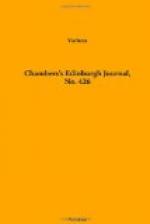Science is not idle in France, notwithstanding the social perturbations: some of our engineers are talking about the trials of electro-magnetic locomotives recently made on one of the railways in that country, and are rather curious as to what may be the result. To travel without the whiz and roar of steam would be a consummation devoutly desired by thousands of travellers. And among the topics from the Academie, there is one important to the naval service—M. Normandy’s apparatus for converting sea-water into fresh water. Briefly described, it is a series of disks, placed one above the other, communicating by concentric galleries, and placed in a vapour-bath at a pressure a little above that of the atmosphere. ’The sea-water,’ says the inventor, ’circulating in the galleries heated by the surrounding vapour, gives off a certain quantity of vapour, which, mingling with the atmospheric air, introduced by a tube from the outside, finally condenses as perfectly aerated fresh water in a refrigerator, which is also in communication with the atmosphere. No other means of agitation or percolation is so efficacious or economical.’ The apparatus, which is free from the defect of depositing salt while distillation is going on, is rather more than three feet in height, and eighteen inches diameter. It will yield two pints of water per minute, at an expenditure of about 2-1/4 lbs. of coal for each 45 lbs. of water.
Next, Monsieur Rochas proposes a method for preserving limestone monuments and sculptures for an indefinite period. This material, as is well known, is very liable to disintegrate, and the remedy is to silicify it. Specimens of limestone so prepared were exhibited to the Academie, but without any explanation of the process. We know that brick and stone have been coated with glass in a few instances, to insure their preservation; and that at Professor Owen’s suggestion, some decomposing ivory ornaments, sent over by Mr Layard, were restored by boiling in gelatine; but M. Rochas aims at something still greater—nothing less than the silicifying of a number of crumbling limestone statues which have been lately discovered by a Frenchman who is exploring the temple of Serapis at Memphis. They will then be strong enough to bear removal.




